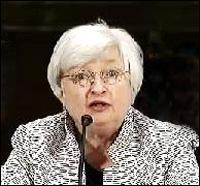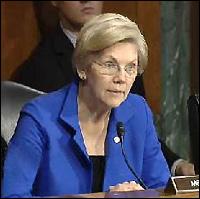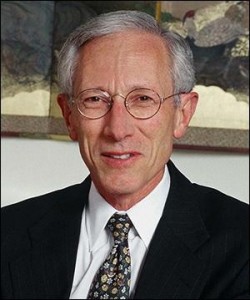By Pam Martens: July 16, 2014
Yesterday, Federal Reserve Chair Janet Yellen delivered her Semiannual Monetary Policy Report to the Senate Banking Committee. Yellen deftly maneuvered questions on slack in the job market, asset bubbles on Wall Street, and assorted digs at the explosion of the Fed’s balance sheet to over $4 trillion as a result of quantitative easing.
When it finally came to the turn of the last Senator on the docket to quiz Yellen, Senator Elizabeth Warren, the Fed Chair gave her a big, warm smile at the beginning of the questioning, likely figuring she was about to steal home and get big kudos for her performance back at the Fed.
Things didn’t go as planned.
Senator Warren has apparently been looking at the bare bones 35-pages released to the public for the various “living wills” or wind-down plans if a systemically important (too-big-to-fail) bank gets into trouble again and compared these to the cryptic, unintelligible tomes of paper that constitute the real wind-down plans behind the Fed’s equally opaque draperies.
Warren opened her questioning of Yellen by reminding the Fed Chair that Section 165 of the financial reform legislation known as Dodd-Frank mandated that large financial institutions submit plans to the Federal Reserve and the FDIC explaining how they could be “rapidly” liquidated without bringing down the economy – as occurred in 2008.
To drive home her point, Warren compared the situation of Lehman Brothers at the time of its collapse in 2008 to the Wall Street behemoth, JPMorgan today. Lehman, said Warren, had $639 billion in assets and 209 subsidiaries when it failed and it took three years to unwind the bank. Today, said Warren, JPMorgan has $2.5 trillion in assets and a staggering 3,391 subsidiaries.
Warren pointedly asked Yellen if these big Wall Street banks had ever given the Fed wind-down plans that were “credible.”
Yellen proceeded to bury herself pretty deeply in her answer. She said it was her “understanding” that there is a “process.” (Surely the Fed Chair should be completely on top of this critical piece of the Fed’s supervisory role of the largest bank holding companies in the country and have more than just an “understanding.”) Yellen went on to say that the wind-down plans are “complex” and some plans encompass “tens of thousands of pages.”
Yellen added: “I think what was intended is this interpretation you’re talking about, whether they’re credible, in other words, do they facilitate an orderly resolution, and I think we need to give these firms feedback.”
“Feedback” to banks which have exponentially increased in size since the greatest economic collapse since the Great Depression and have consistently demonstrated illegal cartel and consumer rip-off behavior was clearly not the answer Warren had in mind.
Warren responded:
“I have to say, Chair Yellen, I think the language in the statute is pretty clear, that you are required, the Fed is required, to call it every year on whether these institutions have a credible plan — and I remind you, there are very effective tools that you have available to you that you can use if those plans are not credible, including forcing these financial institutions to simplify their structure or forcing them to liquidate some of their assets — in other words, break them up.
“And I just want to say one more thing about this process, the plans are designed not just to be reviewed by the Fed and the FDIC, but also to bring some kind of confidence to the marketplace and to the American taxpayer that in fact there really is a plan for doing something if one of these banks starts to implode.”
Warren may have come down hard on the Fed at this hearing because the newly installed Fed Vice Chairman, Stanley Fischer, appeared to be out on the stump last week for keeping the biggest banks intact in a speech he delivered in Cambridge, Massachusetts last Thursday.
Fischer had this to say:
“What about simply breaking up the largest financial institutions? Well, there is no ‘simply’ in this area. At the analytical level, there is the question of what the optimal structure of the financial sector should be. Would a financial system that consisted of a large number of medium-sized and small firms be more stable and more efficient than one with a smaller number of very large firms? That depends on whether there are economies of scale in the financial sector and up to what size of firm they apply–that is to say it depends in part on why there is a financing premium for large firms. If it is economies of scale, the market premium for large firms may be sending the right signals with respect to size. If it is the existence of TBTF, that is not an optimal market incentive, but rather a distortion. What would happen if it was possible precisely to calculate the extent of the subsidy or distortion and require the bank to pay the social cost of the expansion of its activity? This could be done either by varying the deposit insurance rate for the bank or by varying the required capital ratios for SIFIs to fit each bank’s risk profile and structure. This, along with measures to strengthen large banks, would reduce the likelihood of SIFI failure–but could not be relied upon to prevent all failures.”
Fischer added: “In short, actively breaking up the largest banks would be a very complex task, with uncertain payoff.”
There were widespread fears when President Obama announced Fischer as his nominee for Fed Vice Chair that Fischer’s previous ties to Citigroup would prove problematic. Citigroup goes unmentioned in Fischer’s long speech last Thursday despite the fact that Citigroup’s insolvency in 2008 played a major role in the economic meltdown and Citigroup flunked its stress test with the Fed this year — meaning the Fed does not have confidence it could weather a major economic storm.
During Fischer’s tenure at Citigroup, from February 2002 through April 2005, he “amassed a personal fortune of between $14.6 million and $56.3 million” according to Bloomberg News. During that same period, Citigroup was serially charged with fraud and built up off balance sheet debt that would lead to its insolvency in 2008.
On April 28, 2003, the SEC charged that the investment banking business of Citigroup, Salomon Smith Barney, issued “fraudulent” research on telecommunications companies to promote its investment banking business. Jack Grubman, the company’s star telecom analyst, was the point man in the fraud according to the SEC and Citigroup rewarded him handsomely for it. The SEC noted in its complaint that “between 1999 and August 2002, when he left the firm, Grubman’s total compensation exceeded $67.5 million.”
Exactly three months after the SEC’s complaint involving fraudulent research at Citigroup, the SEC charged Citigroup with aiding and abetting the Enron fraud, writing on July 28, 2003 that the company designed complex financial structures to help Enron “(1) inflate reported cash flow from operating activities; (2) underreport cash flow from financing activities; and (3) underreport debt.”
In August 2012, the law firm Kirby McInerney settled a shareholders’ lawsuit against Citigroup for $590 million. The 547-page amended complaint depicts a financial institution that gamed the system with high risk leverage, off-balance-sheet gambles it inevitably lost and dysfunctional checks and balances — all while its Board and regulators nodded off.
The lawyers at Kirby McInerney wrote:
“As plaintiffs’ investigation of Citigroup’s subprime CDOs [Collateralized Debt Obligations] demonstrates, Citigroup’s 2004-2007 subprime CDOs produced tens of billions of dollars of super senior tranches – and, effectively, Citigroup never sold (except with its money-back guarantees) a single one. The essence of an underwriter’s function is to sell the securities it underwrites. Citigroup’s inability/failure to accomplish any such sales was an alarming but unheeded red flag as to the value and liquidity of these instruments. The difficulty in selling these super senior tranches was of Citigroup’s own making: it had stripped yield from these super seniors in order to make the junior tranches more marketable. These super seniors thus became, effectively, all risk and no reward.”
During 2004 and 2005, Citigroup sold $25 billion of CDO commercial paper super senior tranches with a guarantee to repurchase them all, at full price, if collateral concerns ever disrupted the rollover of the commercial paper. In addition to a fee of $375 million for the underwriting, it received $50 million annually for that money-back guarantee. This permitted Citigroup to hide its exposure off its books while boosting revenues by $50 million a year.
In addition, Citigroup created seven off-balance-sheet Structured Investment Vehicles (SIVs), totaling $100 billion. Citigroup used “Enron-like accounting” to disclaim any exposure to the SIVs which did not appear in its public financial statements. This allowed the firm to avoid capital charges and reserves while enjoying income of at least $100 million per year from the SIVs.
Citigroup has never left the headlines since the crisis in 2008. Just this week it agreed to a $7 billion settlement for bilking investors in toxic mortgage bonds. It’s also under investigation for its role in the rigging of the Libor interest rate index and money laundering in Mexico.
For Stanley Fischer to go out on the stump and throw cold water on the idea of breaking up the too-big-to-manage banks without even mentioning the poster child for big bank hubris, Citigroup – a bank which he helped govern in the years leading up to its insolvency – sets a new low at America’s central bank.




